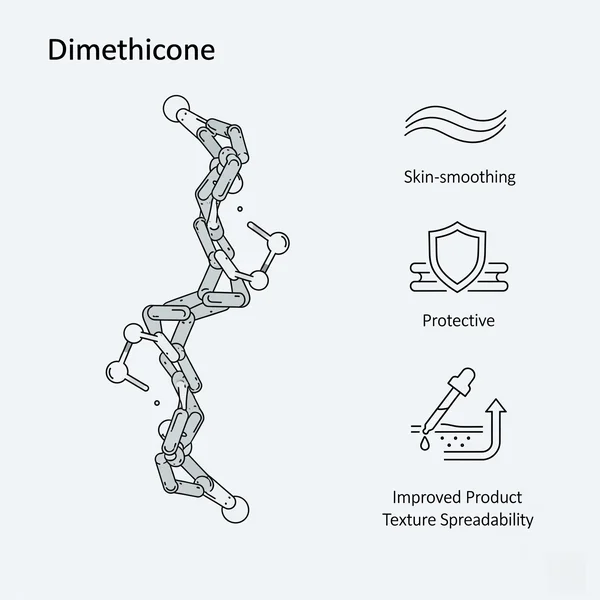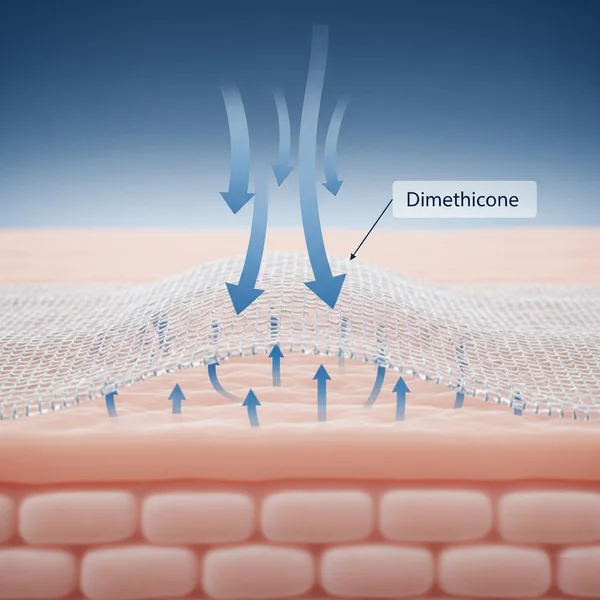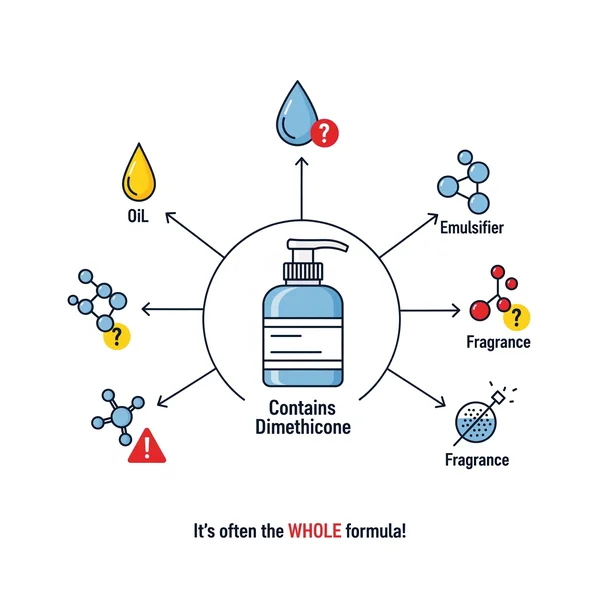Does Dimethicone Clog Pores? Fact vs. Skincare Fiction
Dimethicone. You've likely seen this ingredient pop up in countless skincare and makeup products, from primers that promise a silky-smooth canvas to moisturizers that feel elegantly light. It's lauded for its ability to improve texture and create a protective barrier. Yet, a persistent question shadows this popular silicone: Does dimethicone clog pores? This concern has led many to scrutinize labels and even avoid products containing it. Let's separate skincare fact from fiction and explore the truth about dimethicone in skincare and its relationship with your pores. For a deeper dive into any product's full formulation, you can always use a comprehensive ingredient analysis tool.
What is Dimethicone and Why is it Used in Skincare?
Before we tackle the clogging question, what exactly is dimethicone?
Understanding Silicones: Dimethicone as a Key Example
Dimethicone is a type of silicone-based polymer – essentially, a man-made molecule derived from silica (a natural component of sand and rock). Silicones in skincare are a broad category, and dimethicone is one of the most widely used due to its versatility and safety profile.
Key Functions: Smoothing, Protecting, and Improving Texture
Brands incorporate dimethicone in skincare and makeup for several desirable properties:
- Smoothing Effect: It fills in fine lines and minor imperfections, creating a smoother skin surface and a soft-focus effect. This is why it's a star in primers.
- Protective Barrier: Dimethicone forms a water-repellent film on the skin, which can help lock in moisture and protect the skin barrier from external irritants.
- Improved Texture & Spreadability: It gives products a silky, non-greasy feel and helps them spread more easily across the skin.
- Reduces Tackiness: It can make otherwise sticky formulations feel more elegant.

The Pore-Clogging Debate: Does Dimethicone Suffocate Skin?
The primary concern surrounding dimethicone revolves around its film-forming properties. Does dimethicone clog pores by "suffocating" the skin?
Common Concerns: Trapping Debris and Preventing Skin "Breathing"
Many worry that because dimethicone forms a barrier, it might trap sebum, dead skin cells, and bacteria underneath, leading to clogged pores and dimethicone acne. There's also a common misconception that it prevents the skin from "breathing."
The "Occlusive" Argument: Myth vs. Reality
While dimethicone does have occlusive properties (meaning it helps prevent water loss), it's not occlusive in the same way as heavy, greasy ingredients like petrolatum can be. The term "occlusive" here refers more to its barrier-forming ability to reduce transepidermal water loss (TEWL), rather than creating an impenetrable seal.
The Science: Is Dimethicone Truly a Comedogenic Ingredient?
So, what does the science say about dimethicone being a pore clogging ingredient?
Dimethicone's Molecular Structure: Large and Generally Non-Penetrating
Dimethicone molecules are relatively large. This size generally prevents them from penetrating deep into the pores. Instead, they tend to sit on the surface of the skin, forming that characteristic smooth film.
Forming a "Breathable" Film, Not an Impenetrable Seal
Contrary to the "suffocation" myth, the film formed by dimethicone is considered a breathable film. It allows for the normal exchange of gases (like oxygen and carbon dioxide) while still providing its protective and smoothing benefits. It's not like wrapping your skin in plastic.

Comedogenicity Ratings for Dimethicone
When it comes to comedogenic ingredients, dimethicone typically scores very low on standard comedogenicity scales – often a 0 or 1 out of 5. This means it's generally considered non-comedogenic and unlikely to clog pores on its own.
Why Some People Might Experience Issues with Dimethicone Products
If dimethicone itself isn't usually the culprit, why do some individuals report dimethicone acne or other issues? Several factors can be at play:
Formulation is Key: Other Ingredients in the Mix
This is the most critical point. A product containing dimethicone also contains many other ingredients – oils, esters, emulsifiers, thickeners, etc. Some of these other ingredients could be the actual pore clogging ingredient causing breakouts. It's rarely just one ingredient acting in isolation. Always consider the entire formulation matters, which is why using a detailed ingredient checker is so important.

Potential for "Buildup" if Not Cleansed Properly (Especially with Heavy Silicones)
While dimethicone itself is generally easy to remove with proper cleansing, if products containing heavier silicones in skincare or multiple layers of silicone-based products are used without thorough cleansing, a silicone buildup could potentially occur. This buildup, combined with sebum and dead skin cells, might contribute to congestion for some.
Individual Sensitivities or Reactions (Rare but Possible)
Though uncommon, a very small percentage of people might have a genuine sensitivity to silicones, including dimethicone. This is more likely to manifest as irritation or a rash rather than true comedonal acne.
Using Products Not Suited for Your Skin Type
If you have very oily or acne-prone skin, a very heavy, rich cream laden with multiple silicones (even if dimethicone is low on the comedogenic scale) might still feel too occlusive or contribute to issues, not necessarily because of the dimethicone itself, but the overall product texture and formulation.
Choosing and Using Dimethicone Products Wisely
So, should you avoid dimethicone in skincare? Not necessarily. Here’s how to approach it:
Look at the Entire Ingredient List, Not Just "Dimethicone"
Don't fixate on a single ingredient. Use a reliable online pore congestion analyzer to assess the entire ingredient list for other potential comedogenic ingredients or irritants.
Consider Product Texture and Your Skin Type
If you have oily or acne-prone skin, you might prefer lighter formulations (serums, lotions) where dimethicone is used for slip rather than heavy occlusion. Drier skin types might tolerate richer textures well.
Proper Cleansing is Essential
Ensure you're thoroughly cleansing your skin each evening, especially if you wear makeup or multiple layers of skincare. A good double cleanse (oil cleanser followed by a water-based cleanser) can effectively remove silicone-based products and prevent potential silicone buildup.
Dimethicone Dilemma Solved: Pores Can Breathe Easy
So, does dimethicone clog pores? Based on current scientific understanding, pure dimethicone is generally non-comedogenic and forms a breathable film, making it unlikely to be a primary pore clogging ingredient for most people.
When breakouts or congestion occur with products containing dimethicone, the issue often lies with other comedogenic ingredients in the formulation matters, improper cleansing leading to silicone buildup, or an unsuitable product texture for one's skin type. Don't fall for the "silicone scare." Instead, become an informed consumer by looking at the bigger picture of the entire ingredient list. For this, a robust product ingredient evaluation tool can be your best friend.
What are your experiences with dimethicone in skincare? Share your thoughts below!
Frequently Asked Questions about Dimethicone and Pores
Let's address some common queries:
Q1: Are all silicones the same when it comes to clogging pores?
Are silicones bad for skin? Not inherently. There are many types of silicones in skincare (e.g., cyclopentasiloxane, dimethiconol). While most are considered non-comedogenic, their textures and film-forming properties can vary. Heavier silicones might feel more occlusive to some. It's less about "good" vs. "bad" and more about the overall formulation and your skin's response.
Q2: If dimethicone doesn't clog pores, why does my skin feel "coated"?
Why does dimethicone feel occlusive? Dimethicone is designed to form a smooth film on the skin. This is what gives that silky, "coated" feeling, which helps to lock in moisture and smooth texture. For some, especially those with oily skin, this sensation might be undesirable, even if it's not actually clogging pores.
Q3: Can dimethicone cause acne breakouts in other ways?
Can dimethicone cause acne? While direct pore-clogging by dimethicone is unlikely, if it contributes to a buildup of other substances due to improper cleansing, or if an individual has a rare sensitivity causing irritation, it could indirectly play a role in dimethicone acne for a very small subset of users. However, other ingredients in the product are far more common culprits.
Q4: How do I know if a product contains dimethicone or other silicones?
How to know if a product has silicones? Check the ingredient list! Look for ingredients ending in "-cone" (like dimethicone, methicone, trimethicone), "-siloxane" (like cyclopentasiloxane, cyclohexasiloxane), and "-conol" (like dimethiconol). An ingredient decoder can also help identify them.
Q5: Is it better to choose "silicone-free" products if I have acne-prone skin?
Should I avoid silicones if I have acne? Not necessarily. Many "silicone-free" products might contain other ingredients that are comedogenic or irritating. The "silicone-free" label isn't a guarantee of being acne safe. The most effective approach is to evaluate the entire ingredient list of any product, silicone-containing or not, ideally with the help of an online ingredient checker.